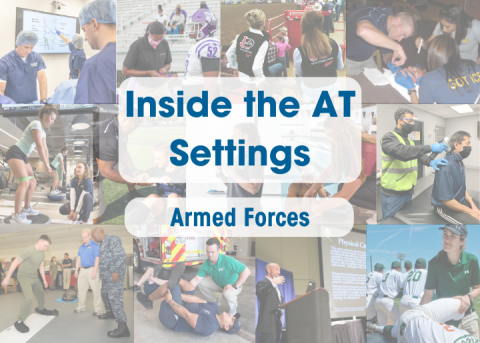
Introduced in the April NATA News, this NATA Now article series provides insight into the different athletic training settings as well as information athletic training students and interested ATs need to know. The series also provides tips from members on how to succeed in each setting.
Brandi Anderson, ATC, CSCS, works with STRIKE, an embedded human performance group at Explosive Ordinance Disposal Command in the U.S. Navy. The team has a program director, two athletic trainers, two certified strength and conditioning specialists, a physical therapist, a nurse case manager and four physiological health professionals overseeing the care of sailors.
“My experience with the military began in 1993 when I was given the opportunity to help an active-duty Navy SEAL with an injury that he had sustained in training,” Anderson said of her transition into the armed forces setting. “He then extended an opportunity for me to meet his command physician, and we began a working relationship to develop a rehabilitation program at their command.”
Keep reading for more insight from Anderson into the armed forces setting.
Typical Makeup of Your Population
All activity duty population with a focus on special operations.
Non-AT-Related Skills/Education/Certification Required or Helpful for Your Setting
One certification is the CSCS, which stands for certified strength and conditioning specialist, offered through the National Strength and Conditioning Association.
Common Injuries Observed or Encountered in Your Setting
All things musculoskeletal – low back, knees and shoulders are most often seen. I also see a variety of post-op, acute, chronic, traumatic and overuse injuries.
Traits of a Successful AT in Your Setting
Being a strong team-player is essential, while setting firm boundaries for patient care and job responsibility. My position requires excellent evaluation and rehabilitation skills as well as progressive care plans for safe return-to-duty.
Misconceptions About Your Setting and/or Patient Population
The military setting is similar to a traditional college setting, where the AT is responsible for the health of athletes and works in a collaborative dynamic with the team physician.
In the armed forces, there is often a larger team that may include medical, physical therapy, occupational therapy, strength coaches, psychological health teams and nurse case managers. This dynamic can come with challenges as many skills within athletic training overlap other professions.
The Defense Health Agency (DHA) has not yet outlined AT privileges within the military; therefore, it can be challenging for commands to clearly define our roles and responsibilities. Our goal is to optimize the AT role and fully support the military by allowing the AT to work in all our domains and within the scope of care outlined by their state practice act.





